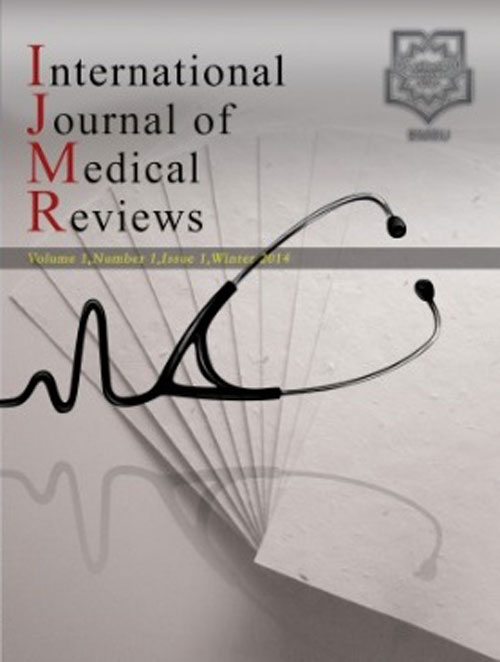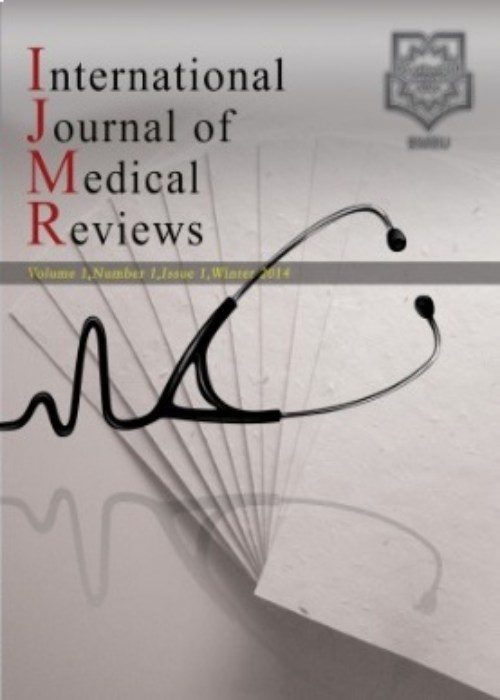فهرست مطالب

International Journal of Medical Reviews
Volume:6 Issue: 2, Spring 2019
- تاریخ انتشار: 1398/04/01
- تعداد عناوین: 7
-
Pages 37-39This study analyzes the symptoms of gastrointestinal stromal tumor (GIST) and its causes from a clinical view to determine when people can say that they suspect a tumor. GIST is a sarcoma that is not common in people; however, even those who have it find it hard to notice, because it does not have symptoms. Furthermore, it does not affect a person in the early stages. The challenge extends to medics who can easily confuse the tumor with another gastric sarcoma. The tumor affects the stomach more, followed by the small intestines, and then the rectum. The cause of the disease is still unknown, although doctors associate it with several inherited syndromes. Syndromes, such as primary familial syndrome, result in a tumor by affecting the gastric tract muscle cells. Some of the symptoms that are likely to show that a person has a sarcoma include abdominal pain and a feeling of fullness earlier than one expects. Doctors can compare these symptoms with the cause of GIST and emphasize the possibility of the presence of a tumor.Keywords: Gastrointestinal Stromal Tumor (GIST), Interstitial Cells of Cajal (ICC), Syndrome, Symptoms, Abdomen
-
Pages 40-44A neoplasm, also referred to as a tumor, is an abnormal mass of tissue, the growth of which exceeds and is uncoordinated with that of normal tissue and remains in the same excessive manner even after removal of the stimuli which evoked the changes. Tumors may be either benign or malignant. Benign tumors remain localized and are amenable to surgical removal, whereas malignant tumors, i.e. cancerous ones, adhere to any part in an obstinate manner, often invade surrounding tissue, and metastasize to distinct sites. Breast cancer occupies second place as the most occurring cancer in terms of incidence. Breast cancer is a heterogenous cancer, mostly linked with reproductive and hormonal factors in its occurrence. Nulliparous, younger age at menarche, early age pregnancy, older age at first live birth, late menopause, prolonged interval between menarche and first pregnancy, repeated abortions, first pregnancy after 35 years, and no/less breastfeeding are major risk factors for breast malignancies. Recent studies have shown that the implications of reproductive and hormonal factors in patients with breast cancer are associated mostly with BRCA1 (breast cancer gene 1) and BRCA2 (breast cancer gene 2) gene mutations.Keywords: Reproduction, Breast Neoplasms, Menarche, Menopause, Neoplasm Metastasis
-
Pages 45-50Fusion genes (FGs) are major molecular biological abnormalities in hematological malignancies and have become well-established molecular markers for disease classification, risk stratification, and targeted therapies. The long tail phenomenon is observed in the distribution of FGs, which means that except for dozens of the most common FGs, the positive rates of the other FGs are all below 1%, even if they have been frequently reported in the literature. However, the total positive rate of these singly relatively rare FGs is actually not low due to their wide variety and numerous members. We therefore put forward the conception “fusion gene family, FG-FM” to describe fusions that share one common protagonist gene with different partner genes. Most of the FGs in hematological malignancies discovered to date can be classified into about 20 major families. Based on the characteristics of the currently reported FGs, it can be expected that although a great many FGs may be identified in the future, the total number of FG-FMs is rather limited. FGs in the same FG-FM often have similarities in pathogenicity, clinical features, and treatment outcomes. Classifying FGs according to FG-FMs will aid in understanding their pathogenicity and optimizing detection schemes.Keywords: Gene Fusion, Fusion Gene Family, Long Tail Phenomenon
-
Pages 51-58Several factors are involved in susceptibility to multiple sclerosis (MS)and alterations in disease activity. A full understanding regarding the mechanism which causes the disease is still lacking. Several factors have been considered to be associated, positively or negatively, with the onset, course, progression, and relapse rates of MS. However, the level of consensus on each factor is different. These factors are either genetic (including polymorphisms in human leukocyte antigen, microRNAs genes, etc) or environmental (such as serum levels of circulating vitamin D, helicobacter pylori, Epstein-Barr virus, human cytomegalovirus, human herpes virus type 6, human endogenous retrovirus infections, and latitude). Vitamin D sufficiency is a major protective factor on which there is a decisive consensus and has known interactions with many factors affecting MS onset/severity. Vitamin D therapy is speculated to exert beneficial effects on patients, the efficacy of which, along with the etiology of MS, is reviewed in this article.Keywords: Multiple Sclerosis, Vitamin D, Therapeutics, Risk Factors, Autoimmunity
-
Pages 59-64Obesity is a chronic, relapsing, progressive disease which is associated with a wide range of fatal diseases in the world. This review article evaluated the efficacy of Lactobacillus gasseri </em>in the management of obesity. The information was extracted from electronic resources (PubMed, Science Direct, Wiley, and Google). The results of the research showed that the efficacy of L. gasseri o</em>n weight loss is strain-sensitive. There are two well-known strains, BNR17 and SBT2055, which come from different sources and are used in many animal and clinical studies. More evidence on the efficacy of L. gasseri </em>SBT2055 than on BNR17 is present in the literature. The daily dose of L. gasseri </em>SBT2055 in clinical trials is higher than BNR17 at the dose of 1011</sup>. It seems that the use of a high dose of L. gasseri </em>BNR17 in clinical trials is associated with more pleasant results on weight loss.Keywords: Lactobacillus gasseri, Obesity, Weight Loss, Clinical studies, SBT2055, BNR17
-
Pages 65-72IntroductionT The prevalence of diabetes among the elderly presents nurses and nurse aides with new challenges to providing high-quality, evidence-based care in nursing homes. Considering the importance of home care, this overview seeks to examine the challenges to organizational home-based care in nursing and nursing patients with diabetes.MethodsA systematic review of intervention studies from between 2012 and 2016 was conducted using standard and sensitive keywords such as: “development,” “implementation,” “evaluation,” “education,” “diabetes patient,” “home care,” and ”nursing homes” with other possible word combinations, such as advancement, assessment, nursing care providers, and home care centers. The databases searched included PubMed, Science Direct, Ovid, Wiley, and Scholar. The articles which met the inclusion criteria and quality standards for this study were selected for review.ResultsOut of 543 retrieved articles, seven articles were analyzed in a case study. Three articles showed the professional development of nurses, the exchange of their experiences, professional self-confidence, increased professional development, and improved communication between care-provider and caregivers.ConclusionsNow more than ever, the lack of continuous training in treatment and care plays a pivotal role among teaching staff as a basic requirement for reducing the incidence of complications of diabetes among individuals, especially the elderly. Getting to know more about the benefits of severe glycemic control in people with advanced disease can help achieve therapeutic goals.Keywords: Challenges, Expansion, Implementation, Evaluation, Training Programs, Patients with Diabetes


